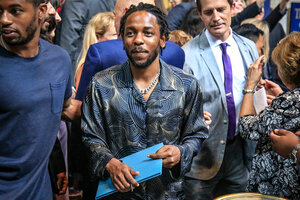‘Heal everybody’: Rapper Kendrick Lamar as caretaker of culture

Rapper Kendrick Lamar holds a certificate after winning the Pulitzer Prize for music for his album "DAMN." during an awards luncheon in New York on May 30, 2018. Up until that point, the award had gone only to music in the classical and jazz genres.
Bebeto Matthews/AP/File
Oftentimes, the best way to look at a cultural icon is through the prism of their contemporaries. Kendrick Lamar, arguably the best rapper in the industry and unarguably a Pulitzer Prize winner, took this a step further in one of his recent presentations.
Prior to the debut last month of his latest album, “Mr. Morale & the Big Steppers,” Mr. Lamar released the fifth installment of his series “The Heart” in a way befitting his legend. He uses deepfakes to morph into the likes of O.J. Simpson, Will Smith, Jussie Smollett, and Kanye West – plus the late Kobe Bryant and Nipsey Hussle. Laced over a sample of Marvin Gaye’s “I Want You,” he provides a critical analysis of what “culture” means to Black people in America.
He then ties that notion into a touching and tragic tribute for Mr. Hussle, a fellow rapper, who was killed in 2019 by a man whose trial is underway now in Los Angeles. The video is Mr. Lamar at his cinematic and empathetic best, and it confirms why he is so beloved among fans. He has a way of humanizing tragedy, which is a lost art, even in the age of mass media, relentless access, and the seemingly endless cycle of death and destruction.
Why We Wrote This
As Pulitzer-Prize winning rapper Kendrick Lamar takes his talents in a new direction, what does his body of work suggest about his influence on culture – and his own perseverance?
The artist uses celebrities – no, celebrity – as an allegory for his own complex and controversial career. The same can be done to outline his upbringing and rise to superstar status. Mr. Lamar is a native of Compton, California, which is also where Venus and Serena Williams grew up. We have learned about the sisters as wunderkinds, who have since dominated tennis both as athletes and entrepreneurs. Where the Williams sisters were fathered into the game by their biological patriarch, Mr. Lamar had two chief figures who led him into celebrity – incomparable producer Dr. Dre, who only a few months ago headlined a nostalgic Super Bowl halftime show, and Anthony “Top Dog” Tiffith, who discovered the musician as a 16-year-old up-and-coming rapper.
His future plans also mirror those of Shawn “Jay-Z” Carter, who has gone from “best rapper” status to so much more than rap. We don’t just recognize him as a rap impresario: Through his partnerships with the NFL and others, we note his status as mogul and business adviser. Mr. Lamar has confirmed that his latest album will be his last on the label Top Dawg Entertainment, as he wants to become more of an entrepreneur.
It was almost 20 years ago when Jay-Z said that “The Black Album” would be his last, a marketing ploy, for certain, and yet, it announced that he would be more than an entertainer. Whether “Mr. Morale” will be Mr. Lamar’s last is less important than his growth as a person.
Even in the midst of massive celebrity, Mr. Lamar feels like he’s one of us. Five years after his last album release, he doesn’t sound passé or preachy in his songs or the video. He is as relevant and raw as ever, which constitutes so much of his legacy.
His lyrics, while profane, are piercing. Even when he approaches topics from flawed ideology, his sins are forgiven because of a willingness to convey the realities of life – his own and that of a society’s. As described on “Mother I Sober” off the new album:
I’m sensitive, I feel everything, I feel everybody
One man standin’ on two words, heal everybody.
He is not perfect, but he is a pastor of sorts. As displayed on “The Heart Part 5,” he is full of fire and brimstone, then suddenly compassionate. He is a modern-day Tupac Shakur, conflicted, conscious, unrelenting. California love, indeed.
Where Mr. Shakur’s life was tragically cut short at age 25, Mr. Lamar just celebrated his 35th birthday with family and friends. While he is still relatively young, it feels as if he has lived a few lifetimes.
Adversity will do that to you. As described by the musician in various lyrics, he has dealt with everything from depression to sex addiction to proximity to various abuses. Where that journey may have doomed a lesser man, it seemingly made Mr. Lamar stronger. The way that he wears his heart on his sleeve, not just fashionably, but functionally, is a refreshing example in a world that would rather say, as Charles Barkley once did, “I am not a role model.”
Humanity, hope, and healing. These are the cornerstones of Kendrick Lamar’s legacy, and if the last words of his latest album are any indication, he is ready to prioritize self-reflection over community critique:
Sorry I didn’t save the world, my friend
I was too busy buildin’ mine again.
Ken Makin is the host of the “Makin’ A Difference” podcast.
Editor’s note: This article has been updated to correct information about Serena and Venus’ time in Compton, California. They grew up there.
